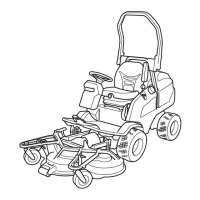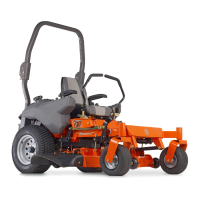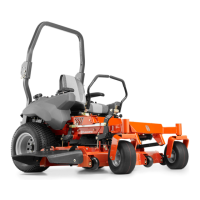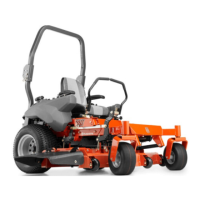Why is my Husqvarna P 525D releasing white smoke?
- SsfernandezSep 3, 2025
If your Husqvarna Lawn Mower is releasing white smoke, it could be due to a defective cylinder in the engine or the engine oil level being too high.

Why is my Husqvarna P 525D releasing white smoke?
If your Husqvarna Lawn Mower is releasing white smoke, it could be due to a defective cylinder in the engine or the engine oil level being too high.
Why is my Husqvarna P 525D Lawn Mower releasing blue smoke?
If your Husqvarna Lawn Mower is releasing blue smoke, it could be because the engine oil level is too high or the engine is defective.
Why is my Husqvarna P 525D engine not running smoothly?
If your Husqvarna Lawn Mower engine is not running smoothly, several factors could be responsible. The fuel filter might be clogged, or the air filter could be dirty. A blocked fuel tank vent, low feed pressure, or a loose injector pipe could also be the cause. The engine itself, incorrect fuel type, a defective relief valve, fuel injector, injection pump, or feed pump might also be to blame. To address some of these issues, refer to the manual on how to replace the fuel filters and how to clean and replace the air filter.
What to do if my Husqvarna P 525D battery does not charge?
If the battery does not charge, it could be defective or the connection at the cable connectors on the battery terminals is bad. Speak to your Husqvarna service agent if the battery is defective.
Why is my Husqvarna P 525D releasing black smoke?
Black smoke from the product might be due to: A defective fuel injector, incorrect fuel type in the fuel tank, a clogged air filter, or a defective injection pump. Refer to page 31 to clean and replace the air filter.
Why does my Husqvarna Lawn Mower engine have no power?
If the engine seems to have no power, the following reasons may apply: The air filter or fuel filter could be clogged. There might be air in the fuel system. The relief valve or feed pump could be defective. The feed pressure could be too low. The timing of the fuel injection pump might be defective, or the engine itself could be defective. Refer to page 31 to clean and replace the air filter and to replace the fuel filters.
How to fix a Husqvarna P 525D Lawn Mower engine that does not run smoothly?
An engine that doesn't run smoothly may be caused by several factors: The fuel filter or air filter could be clogged. The fuel tank vent might be blocked. The feed pressure could be too low, or the injector pipe might be loose. The engine itself, the fuel type, the relief valve, the fuel injector, the injection pump, or the feed pump could be defective. Refer to page 31 to replace the fuel filters and to clean/replace the air filter.
What to do if my Husqvarna P 525D engine won't start even when the start motor turns?
If the engine doesn't start even when the start motor turns it over, check for these potential causes: There might be no fuel in the fuel tank. There could be air in the fuel system. The ignition cable or the engine itself might be defective. Refer to page 17 to fill fuel.
| Brand | Husqvarna |
|---|---|
| Model | P 525D |
| Category | Lawn Mower |
| Language | English |
Detailed steps for initial machine setup and checks before delivery.
Recommended maintenance tasks after the initial 25 hours of operation.
Guidelines for road use, public transport, and securing the machine.
Specific instructions for towing and the intended application of the machine.
Importance of dealer service and documentation for machine longevity and value.
Explanation of graphical symbols used on the machine and in the operator's manual.
Identification and numbering of all machine controls and their functions.
Essential safety precautions for operating the machine safely.
Warnings related to electromagnetic fields, hot surfaces, and exhaust fumes.
Guidelines for safe operation, especially on sloped terrain.
Precautions regarding clothing, footwear, and first aid.
Measures to ensure child safety around operating machinery.
Safety procedures for maintenance, fueling, and battery handling.
Procedures and precautions for safely transporting the machine.
Introduction to the machine's design, steering, and power transmission.
Explanation of throttle, speed limiter, and cutting unit engagement.
Instructions for adjusting cutting height and using the hydraulic lift.
How to start, stop, and safety features related to the cutting unit.
Details on seat adjustment and safe fueling procedures.
Information on operating lights and using the 12V power outlet.
Explanation of dashboard indicators and bypass valve function.
Guidance on using the Roll Over Protective Structure and safety belts.
How the auxiliary lift system works and its adjustment.
Steps and checks required before starting the engine.
Process for starting the engine and initial warm-up recommendations.
Advice for starting in cold conditions and using appropriate fuel.
Procedures for jump-starting the engine with a weak battery.
Instructions for driving, braking, and stopping the machine.
Tips for optimal mowing results and terrain handling.
Comprehensive schedule of required maintenance tasks and intervals.
Instructions for cleaning the machine, including covers and radiator.
Steps for removing engine cover, service hatch, and transmission cover.
Adjusting and changing pump, alternator, and PTO belts.
Inspection of muffler, adjustment of parking brake, and fuel filter replacement.
Procedures for cleaning, emptying, and replacing the air filter.
Verification of safety systems and maintenance of lighting components.
Ensuring correct tire pressure for optimal performance.
Battery inspection and steps for fitting the cutting head.
Detailed steps for safely removing the cutting unit from the machine.
How to place and secure the cutting unit for servicing.
Returning the unit from service position and adjusting cutting height.
Adjusting tilt angle and replacing cutting unit belts.
Checking blades for damage and removing the BioClip plug.
Procedures for adjusting and replacing PTO belts.
Instructions for changing coolant and maintaining the cooling system.
Guide to lubrication points, frequency, and general lubrication advice.
Lubrication points for pivot wheels, drive shafts, cutting unit bracket, lift arms, and lift cylinder.
Lubrication for drive shaft bearings, steering cylinder, joint bearing, and link brace.
Steps to check and maintain the engine oil level.
Procedures for changing engine oil and replacing the oil filter.
How to check the hydraulic system oil level.
Checking transmission oil and lubricating cutting height knobs.
Lubricating driver seat components and various cables.
Diagnosing and resolving problems with engine starting and smooth operation.
Identifying causes of abnormal exhaust smoke and loss of engine power.
Troubleshooting engine overheating, battery charging, and machine vibration.
Diagnosing and fixing problems related to uneven mowing.
Introduction to the electrical system and location of wiring diagrams.
Procedures for preparing the machine for long-term storage.
Recommendations for annual servicing and using the storage guard.
Detailed technical data including dimensions, engine, electrical, and fluid capacities.
Specifications for cutting units and sound/vibration levels.
EC declaration of conformity and important legal notices.











